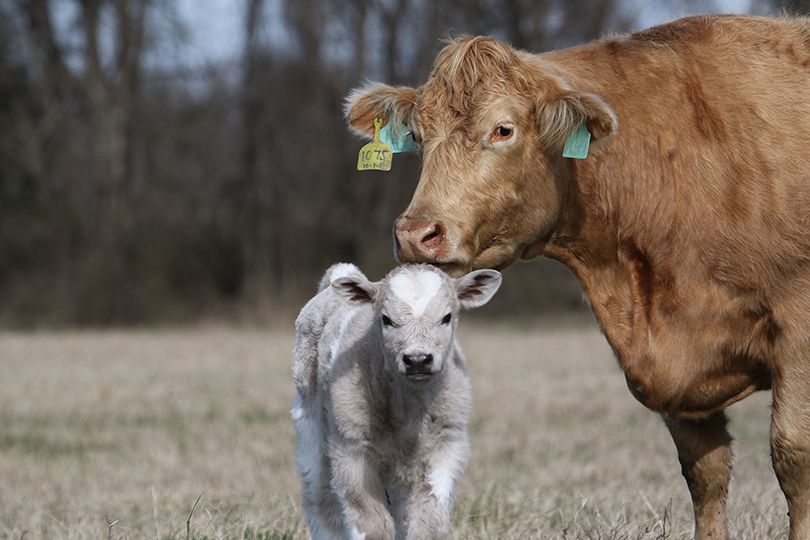By Jennifer Dorsett
Field Editor
In Texas, January to April is considered spring calving season.
Knowing the signs of impending labor can help identify those cows most likely to give birth soon and will help ranchers be prepared, Texas A&M AgriLife Extension Service Extension Livestock Specialist Dr. Ron Gill said.
Most cows will start behaving differently and begin standing away from the herd or go off by themselves, Gill noted.
“Cows start looking for a place to have a calf probably a day or two before they have one. They’ll scope out a pasture or a paddock, whatever they might be in, and then find a place they’d prefer to have it,” he said in an interview with the Texas Farm Bureau Radio Network.
Restlessness, pacing, getting up and lying down and shifting positions frequently are other signs that the laboring process will begin shortly. Gill said carrying the tail higher is also another indicator.
“They will start carrying their tail out behind them. Tail heads elevate as the pelvis starts to relax to allow the calf to come through,” he said. “Shortly before they calve, there will be an indentation between the pelvis and the tail head, where you see a sunken place, and that’s a really good sign that it’s getting pretty close. It’s not saying it’s imminent, but that’s something most of them do before they calve.”
Once a cow is in labor, she may be able to complete the birthing process by herself, or she may need some human assistance. Determining when to step in can be tricky, but Gill said generally once the cow’s water has broken, a calf should be on the ground within two hours.
“You don’t want to rush it, because they have to go through the dilation process, and you can tear the cervix or the vulva if you pull too soon. So, you do have to give them time to work that calf up. But after you see the placental membrane break, in about two hours, that calf ought to be out of there,” Gill said. “When you find a laboring cow, check the calf and make a note of where the feet are, where the nose is. As long as they’re making progress, I don’t know that I’d intervene. But when you see that progress stop and they are really trying and they’re laying down and straining and having contractions and nothing’s happening, then I’d go ahead and pull the calf.”
Heifers are more likely to experience complications, so Gill advises ranchers to keep a closer eye on them during calving season.
“Some people are doing ultrasounds, blood tests or regular palpations and sorting heifers into calving groups. That way, you can have the ones calving earliest in the season up close and watching them, and you don’t have to move all your heifers up yet. So, it makes things a little more simple,” he said. “Having a facility and the proper tools to assist them really helps you out in the long run.”
He recommends setting up calving stalls, or prefabricated stalls equipped with head catches and fold-down sides, as well as creating a “calving kit” with tools and equipment needed for difficult births.
“Some people just use their squeeze chute, but the biggest thing is to have the animals in a location that you can get them up if need be,” he said.
Calf pullers, chains, palpation or AI sleeves, surgical gloves, sterile lubricant and blankets are all useful tools when faced with difficult births or dystocia. Gill does not recommend the use of a “come-along” or cable winch puller unless necessary.
“The calf puller needs to be one of those things that you keep maintained. There are some that ratchet in alternating strokes, and the reason those are preferred is it doesn’t pull all at one time. It’ll pull one leg and then the other, and it helps work the calf out, rather than pull it out,” Gill said. “One of the downsides of using a come-along, it’s just pulling at one force. But these really good calf pullers fit down over their hips. They’re nice to have, particularly if you’re in the situation where you can get the animal restrained and get the chain going and the pullers hooked up right, they help.”
AgriLife has several publications ranchers may find useful for calving season.
An older booklet, which Gill said is still useful, Recognizing and Handling Calving Problems, is also available.
Avoiding Calving Problems discusses causes of dystocia and ways to avoid it, including appropriate heifer and bull selection.
Another publication, Assisting Difficult Calving, explains each stage of parturition.
A video lecture on dystocia by Dr. Thomas Hairgrove, associate professor and Extension specialist for the Department of Animal Science at Texas A&M University, may provide additional insight, Gill added.
Hear more from Gill on the Texas Farm Bureau Radio Network.

